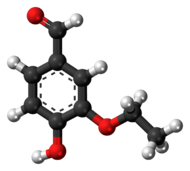Ethylvanillin
Ethylvanillin is the organic compound with the formula (C2H5O)(HO)C6H3CHO. This colorless solid consists of a benzene ring with hydroxyl, ethoxy, and formyl groups on the 4, 3, and 1 positions, respectively. It is a homologue of vanillin, differing on the 3 position.

| |

| |

| |
| Names | |
|---|---|
| Preferred IUPAC name
3-Ethoxy-4-hydroxybenzaldehyde | |
| Other names
Bourbonal
| |
| Identifiers | |
3D model (JSmol)
|
|
| ChEBI | |
| ChEMBL | |
| ChemSpider | |
| KEGG | |
PubChem CID
|
|
| UNII | |
| |
| |
| Properties | |
| C9H10O3 | |
| Molar mass | 166.176 g·mol−1 |
| Appearance | Colourless powder |
| Density | 1.186 g/mL |
| Melting point | 76 °C (169 °F; 349 K) |
| Boiling point | 295.1 °C (563.2 °F; 568.2 K) |
| Slightly soluble in water | |
| Hazards | |
| Occupational safety and health (OHS/OSH): | |
Main hazards
|
Harmful, irritant |
| GHS labelling: | |

| |
| Warning | |
| H319, H402 | |
| P264, P273, P280, P305+P351+P338, P337+P313, P501 | |
| NFPA 704 (fire diamond) | <imagemap>
File:NFPA 704.svg|80px|alt=NFPA 704 four-colored diamond poly 150 150 300 300 150 450 0 300 Health 2: Intense or continued but not chronic exposure could cause temporary incapacitation or possible residual injury. E.g. chloroform poly 300 0 450 150 300 300 150 150 Flammability 1: Must be pre-heated before ignition can occur. Flash point over 93 °C (200 °F). E.g. canola oil poly 450 150 600 300 450 450 300 300 Instability 0: Normally stable, even under fire exposure conditions, and is not reactive with water. E.g. liquid nitrogen poly 300 300 450 450 300 600 150 450 Special hazards (white): no code desc none </imagemap> |
| Flash point | 145 °C (293 °F; 418.15K) |
Except where otherwise noted, data are given for materials in their standard state (at 25 °C [77 °F], 100 kPa).
| |
Preparation
Ethylvanillin is prepared from catechol, beginning with ethylation to give guaethol (1). This ether condenses with glyoxylic acid to give the corresponding mandelic acid derivative (2), which by oxidation (3) and decarboxylation, gives ethylvanillin (4).[1]
Application
As a flavorant, ethylvanillin is about three times as potent as vanillin and is used in the production of chocolate.[1]
The molecule revolutionized both the design and aesthetics of olfactory art; artist Jacques Guerlain added a large quantity of it to a bottle of Jicky (1889) perfume, creating the main accord for the perfume house's flagship fragrance, Shalimar (perfume) (1925). This is one of the earliest uses of synthetic molecules that freed scent artists from the limits of natural materials.[2]
References
- ^ 1.0 1.1 Karl-Georg Fahlbusch, Franz-Josef Hammerschmidt, Johannes Panten, Wilhelm Pickenhagen, Dietmar Schatkowski, Kurt Bauer, Dorothea Garbe, Horst Surburg "Flavors and Fragrances" in Ullmann's Encyclopedia of Industrial Chemistry, Wiley-VCH, Weinheim: 2002. Published online: 15 January 2003; doi:10.1002/14356007.a11_141.
- ^ "Vanillin:Molecule of the Month". Bristol University.